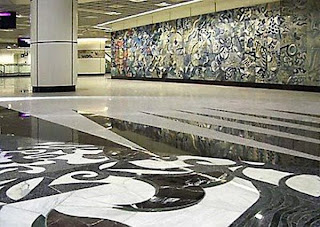Time to "Make it Happen", the crowd-sourcing challenge to see if my big ideas can come to fruition thanks to the rich community of creatives, writers, artists, designers, inventors, scientists, architects, pharmacologists, techies, provocateurs, ethicists, military contractors, etc.
OBJECTIVE:
Plot a new career path for the soon to be ex-FreeCreditReport Band.
Check
this out for more background, but to surmise, the financially inept, "love to hate" band in the FreeCreditReport.com ads have been dropped. The financial company is looking for a new band to sing a whole new initiative for them.
It's a sudden end to to an incredulous gig for the Montreal native "musicians". It all started three years ago and since then they've created images and sounds that will surely haunt us for the rest of our lives. Who can forget their "Pirates of Pity" jam. The "Roller coaster" sing along left a whole audience ready to hurl along with them. And the "Twits in Tights" routine at the Renaissance Fair...well it really doesn't need any more explanation.
F. Scott Fitzgerald once wrote "There are no second acts in American lives". How can we prove him dead wrong (we've got the dead part down) by creating a golden future for the FreeCreditReport Band.
THOUGHT STARTERS:
- Let's get the obvious thought out of the way first. Is there any merit to creating a Facebook campaign to persuade FreeCreditReport.com to reinstate the band. (This may be a really tough sell given that FCR will be incorporating social media to find their new band.)
- What about other potential advertising gigs? What other appropriate brands could they sing for? Monster.com seems like an ideal partner. Theladders.com may be out of their range though.
- Or perhaps they could become the "House band" for a financial related TV show. For example, "The Suze Orman Show" on CNBC.
- Reinvention usually starts with a new band name, and new image. What names could break through the clutter and capture the public's imagination? Here are a few possible examples: The Broken Legs; Pre-Approved; Are you kidding me; The Furry Parts; Born Out Of Wedlock.
- Perhaps the band needs to start playing real gigs to build up an audience base. How do we can get them onto the wedding, bar mitzvah and advertising industry party circuit?
- "American Idol" has a vacancy at the judging position. The band would seem to be ideal candidates, especially given that the producers of the show have lately been employing judges with no real music talent (Ellen Degeneres).
- The aforementioned Ellen Degeneres has just started her own
record label. Her first signing is some kid with a youtube hit, proving she is a music executive with no taste levels whatsoever. Surely it couldn't be that hard to get the band to be her second signing.
- One hit wonders end up on VH1. Could we create a reality series featuring the band as they try to get signed up by a major label. Maybe even Ellen's.
- Perhaps if one of the members was to suddenly "expire", we may be able to create some sympathy for the band which could result in the break they need. It could even lead to a social media campaign to find the ideal replacement.
- Could we possibly interest major producers to get behind the band? What could intrigue Snoop Dog to want to collaborate with them, other than bribing him with marijuana?
- If their music career doesn't pan out where else can they apply their talent or lack thereof? Could they take their "financial experience" as credit spokesmen to the airwaves as experts on Fox Business Channel. They should fit right in.
MANDATORIES: - The band MUST at all times disparage FreeCreditReport.com
- The band can never write their own material.
- The old lady that appears with them in their ads must always be included in their entourage.
- The band must submit to regular credit score testing.
Good luck and make it happen, people!


















































